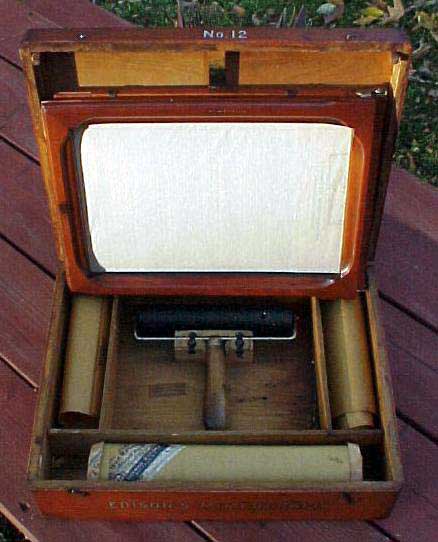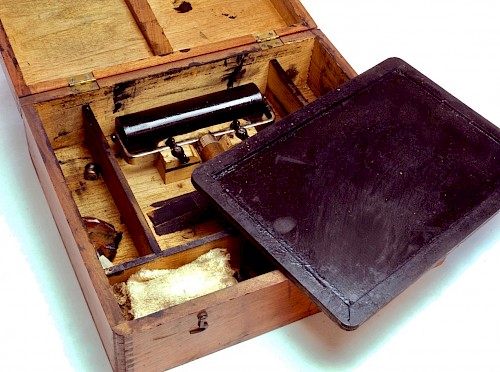The Mimeograph
An important piece of dead technology that contributes to the way that modern office systems work today is the mimeograph. The mimeograph is an early copy machine that works by using a stencil of something you want to make a copy of on paper and forcing ink through it so that the design is printed onto a new sheet of paper, as shown by the pictures below. In the late 1870’s, Thomas Edison contributed several inventions that he created towards the commercial mimeograph machine that was patented by Alfred Blake Dick in the 1880’s. The mimeograph was popular due to its relatively low cost and widespread availability. Below are two photos that show early versions of the machine and a third photo showing a later model from about 1910.



After the mimeograph’s invention in the 1880’s, it was used widely throughout time until about the late 1960’s when it began to be phased out by Xerox photocopier machines which were invented in 1959. However, it was used by some who resisted the new photocopier machines until the 1980’s. The mimeograph was used in schools, churches, small businesses, and in the music and art industries to create inexpensive copies of pages efficiently and it was able to produce hundreds of copies. Although printing had already existed for hundreds of years, the mimeograph was a coveted technology because it allowed one to make copies of an already printed page quickly. The stencil was a crucial part of the mimeograph and was often created by hand using an electric pen that was also invented by Edison or by placing it in a typewriter. Often, stencils were also created using a thermal infrared method or by an electrostencil machine. The stencil would over time deteriorate and lose its pattern, and in this situation another stencil must be created.
Spirit duplicators were a similar technology that created copies, however they proved to create a less clear image because it did not use as dark of an ink. Both were used in schools and publishing establishments in order to create cheap copies with little effort; however, they differed in appearance and longevity. Below are two images that show example of pages printed with a mimeograph (1st image) versus a spirit duplicator (2nd).


The size and shape of the mimeograph machine definitely changed over time to become more contemporary and it began to be produced by a variety of different companies. Pictured below is a mimeograph from 1961 that was produced by Standard Rocket. A normal mimeograph during this time would have cost anywhere from $50-$100 depending on the version and producer. The mimeograph proved to have a large impact on the literary scene as small authors who were unpublished were able to create inexpensive copies of their writings for distribution. Mimeographs were essential for independent authors who wanted to reach a large audience as well as creators of bulletins and newsletters. Looking at historical articles, mimeographs also played a large role in the distribution of propaganda in the 1950’s and 60’s and especially in the student population. Copies created by mimeographs were said to have a more DIY look and this appealed to those who did not follow mainstream publications. Mimeographs were eventually phased out when Xerox photocopiers were invented and became more efficient, however mimeographs were still used by some until the 1980’s. According to a National Geographic article on the “Mimeograph Revolution,” mimeographs were used well into the 1980’s during feminist movements and in underground music scenes. Here is an interesting video that shows how the mimeograph was used near the 60’s and demonstrates how much effort must be put in to make copies of a page. Below is a photo of a later version the mimeograph and a 1967 fanzine produced using a mimeograph. It is a rock and roll bulletin with Jimi Hendrix on the cover


Photocopying machines were introduced into wide-spread commercial use in 1959 by Xerox, a company that most of us have heard of today. Photocopiers became very popular and eventually replaced mimeographs and other copying technologies because they had many more capabilities and used xerography, a much simpler process. Mimeographs in schools and offices were replaced by these photocopiers and they became almost obsolete, aside from the aforementioned uses. However, photocopiers are also predicted to become a dead technology in the future due to the creation, storage, and distribution of information digitally. Today, we simply go to a printer station on campus to make a copy and it does most of the work for us. However, it has become clear to me how much work one would have had to put in to create a copy of a single sheet of paper using a mimeograph. I am not surprised that mimeographs became a dead technology because they did not use any digital copying techniques and it all had to be done by hand. It would be interesting to me to see 20 years what will happen to photocopiers and if they will be an antiquated technology.
Bibliography
“Copying Machines.” Early Office Museum. Accessed May 6, 2020. https://www.officemuseum.com/copy_machines.htm. This source was very useful as it gave a very detailed history of the mimeograph. The Early Office museum published this information about the mimeograph for anyone interested in learning about supplies that used to be used in offices. It is very reputable because it is a digital museum that sources its information from libraries, historical societies, and private collectors.
Hawley, E. Haven. “Revaluing Mimeographs as Historical Sources.” RBM: A Journal of Rare Books, Manuscripts, and Cultural Heritage 15 (2014): 40-55. Accessed May 6, 2020. https://rbm.acrl.org/index.php/rbm/article/viewFile/414/414. This article was very helpful in shining light on the history of the mimeograph and its invention. It was created by E. Haven Hawley, a historian of technology and science, and it was created to inform anyone one who was curious about the mimeograph. It is reliable because it was formally published in a journal and was created by a historian.
“Mimeograph Machines.” Museum of Printing. Accessed May 6, 2020. https://museumofprinting.org/blog/mimeograph-machines/. This information on the mimeograph was very useful because it provided a simple history of it. It was created by the Museum of Printing which is based in Haverhill, MA and is meant for an audience of those interested in old and modern forms of printing. It is very reputable because it is a museum and is an informational organization.
Santosus, Megan. “A History of the Mimeograph.” CIO. Last modified September 15, 2001. Accessed May 6, 2020. https://www.cio.com/article/2441286/a-history-of-the-mimeograph.html. This was a short article that briefly talked about the mimeograph. It was authored by Megan Santosus, an editor for IDC. The audience is anyone who reads through the website that focuses on technology and science and anyone interested in copying systems. This source is reputable because it is an informational article published by a reputable IT news source.
Thompson, Clive. “How the Photocopier Changed the Way We Worked—and Played.” Smithsonian Magazine, March 2015. Accessed May 6, 2020. https://www.smithsonianmag.com/history/duplication-nation-3D-printing-rise-180954332/. This was a very informative article in the Smithsonian Magazine that helped inform me about photocopiers. This article was written by Clive Thompson, a journalist who writes about technology science. The audience is anyone who is interested in learning about photocopiers and their evolution. This article is very reputable because it was published in Smithsonian Magazine and is from a reliable author.
Weber, Greta. “How an Obsolete Copy Machine Started a Revolution.” National Geographic. Accessed May 6, 2020. https://www.nationalgeographic.com/news/2016/06/mimeo-mimeograph-revolution-literature-beat-poetry-activism/. The source was very helpful in learning about the history of the mimeograph and the impact it had on culture during its use. This article was written by a journalist and she created it for anyone interested in print technology. It is reputable because she used many sources and quotes. It provided valuable information for my essay and shined light on the cultural impact of the mimeograph.
Enter text in Markdown. Use the toolbar above, or click the ? button for formatting help.